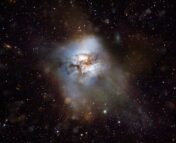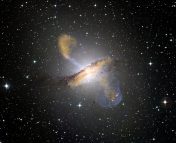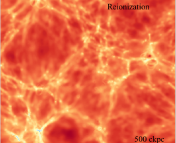Paper Title: ALMA Confirmation of an Obscured Hyperluminous Radio-Loud AGN at z=6.853 Associated with a Dusty Starburst in the 1.5 deg2 COSMOS Field
Authors: Ryan Endsley, Daniel P. Stark, Jianwei Lyu, Feige Wang, Jinyi Yang, Xiaohui Fan, Renske Smit, Rychard Bouwens, Kevin Hainline, Sander Schouws
First Author’s Institution: Steward Observatory, University of Arizona, 933 N Cherry Ave, Tucson, AZ 85721 USA
Status: Submitted to MNRAS [closed access]
Somewhat counterintuitively, gaining a complete understanding of the population of the biggest, brightest galaxies in the early Universe can be challenging. First, while they are highly luminous, they are often quite rare, meaning we need to survey large regions of the sky to detect any at all. Most of the data we have that is deep enough to peer back into the first billion years of the cosmos covers only a small area, leaving it up to chance whether or not a monster is lurking where we’re looking.
Second, many of these massive systems are cloaked in dust, obscuring their short wavelength light. An object that is intrinsically bright due to the presence of lots of forming stars and/or an accreting supermassive black hole at its center may be almost invisible to optical and near infrared telescopes. However, their dust cloak absorbs this bright light and heats up, causing it to emit at longer wavelengths, which we can detect with far infrared and radio telescopes.
By expanding the search for the extreme to probe both wider areas of the sky and more wavelengths of the electromagnetic spectrum, astronomers have been able to identify and characterize extreme populations in the first billion years such as dusty star-forming galaxies (massive, dust-obscured, extreme starbursts like this one) and quasars (massive galaxies hosting active galactic nuclei (AGN) with relativistic jets like this one). These two massive galaxy populations – one dominated by star formation and obscured by dust, and the next overpowered by an accreting supermassive black hole and dominated by its AGN – may be evolutionarily linked. Yet, the transition state between these two phases in a massive galaxy’s lifetime remains unclear. Today’s authors report the confirmation of another type of rare early Universe object that may bridge the gap between these two massive galaxy populations. This possible intermediate (though still extreme) system is a massive, intensely star-forming galaxy with a heavily dust-obscured AGN.
Introducing COS-87259
The galaxy featured in today’s paper, COS-87259, was known and suspected to be a massive early galaxy based on a relatively small (1.5 deg2) but deep survey of the COSMOS field. Yet, without the more detailed data collected by today’s authors, its nature remained unconfirmed. By compiling data from a range of wavelengths together with their new ALMA observations of far infrared emission from the dust and gas in the galaxy, the astronomers put together a more comprehensive picture of the galaxy.
Their first major result was confirmation of the redshift of the galaxy from their detection of the [CII] emission line. With a precise spectroscopic redshift of z = 6.8532, the galaxy exists very early on, when the Universe was less than a billion years old. This is in excellent agreement with estimates based on the optical and near-infrared photometry collected in the previous surveys.
Taking a closer look at the [CII] emission line and the continuum emission from dust, they found a compact core and some extended emission (see Figure 1). Comparing this to observations of COS-87259 at radio wavelengths, they found a spatial offset between the two. This spatial offset suggests the radio emission is powered by something else other than star formation activity, and is likely caused by a jet originating from the AGN.
![Composite image showing detections of the galaxy at various wavelengths. The [CII], dust, and rest-UV detections are fairly coincident while the radio emission is notably offset.](https://astrobites.org/wp-content/uploads/2022/06/Screen-Shot-2022-06-05-at-5.11.12-PM.png)
How does it compare?
Taking all the clues they had from x-ray, ultraviolet, optical, near infrared, far infrared, and radio emission all together, the authors conclude that COS-87259 is a heavily obscured, hyperluminous extremely starbursting galaxy with a radio-loud active galactic nucleus. In other words, COS-87259 has a dusty invisibility cloak at short wavelengths, shines much brighter than normal active galaxies, forms stars at a very high rate, and has an actively accreting supermassive black hole with a relativistic jet. Looking at other objects that exist in the very early Universe (redshift z > 6.5), they find it is among the most extreme in terms of its luminosity and properties at far infrared wavelengths.
The authors also estimate the mass of its supermassive black hole, and find that relative to its amount of mass in stars, it seems to have an extra large supermassive black hole compared to empirical relations. If this is the case, it’s possible that the growth of supermassive black holes outpaced the growth of their host galaxies at early times, providing clues as to how supermassive black holes and their host galaxies evolved together and in what order they grew. This leaves an outstanding question for future studies: did systems with the most massive black holes at early times have heavily obscured phases like we see for COS-87259?
Given that COS-87259 is such a bright object with so much dust and so much active star formation, not to mention a bright (i.e., radio loud) active galactic nucleus, it begs the question: how rare is it? Turns out, it’s super rare! The authors estimate there is 1 per 3000 deg2, and by chance it was found in a 1.5 deg2 field. This is quite promising for future surveys deep and wide like those planned for the next big space telescope, JWST – it’s likely that more rare, hyperluminous and heavily obscured galaxies like COS-87259 will be uncovered behind their dust!
Astrobite edited by Alice Curtin
Featured image credit: NASA/Spitzer Space Telescope (dusty galaxy)




